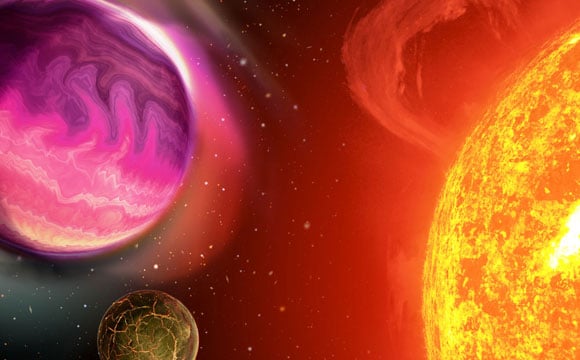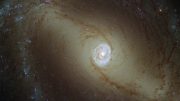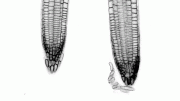
Astronomers have discovered a new binary system, HD 87646, which challenges current theories on how planets form.
Binary system HD 87646 raises new questions about how protoplanetary disks form.
Everything we know about the formation of solar systems might be wrong, says University of Florida astronomy professor Jian Ge and his postdoc, Bo Ma. They’ve discovered the first “binary–binary” – two massive companions around one star in a close binary system, one so-called giant planet and one brown dwarf. The first, called MARVELS-7a, is 12 times the mass of Jupiter, while the second, MARVELS-7b, has 57 times the mass of Jupiter.
Astronomers believe that planets in our solar system formed from a collapsed disk-like gaseous cloud, with our largest planet, Jupiter, buffered from smaller planets by the asteroid belt. In the new binary system, HD 87646, the two giant companions are close to the minimum mass for burning deuterium and hydrogen, meaning that they have accumulated far more dust and gas than what a typical collapsed disk-like gaseous cloud can provide. They were likely formed through another mechanism. The stability of the system despite such massive bodies in close proximity raises new questions about how protoplanetary disks form. The findings will be published in the November issue of the Astronomical Journal.
HD 87646’s primary star is 12 percent more massive than our sun, yet is only 22 astronomical units away from its secondary, a star about 10 percent less massive than our sun, roughly the distance between the sun and Uranus in our solar system. An astronomical unit is the mean distance between the center of the Earth and our sun, but in cosmic terms, is a relatively short distance. Within such a short distance, two giant companions are orbiting the primary star at about 0.1 and 1.5 astronomical units away. For such large companion objects to be stable so close together defies our current popular theories on how solar systems form.
The planet-hunting Doppler instrument W.M. Keck Exoplanet Tracker, or KeckET, developed by a team led by Ge at the Sloan Digital Sky Survey telescope at Apache Point Observatory in New Mexico, is unusual in that it can simultaneously observe dozens of celestial bodies. Ge says this discovery would not have been possible without a multiple-object Doppler measurement capability such as KeckET to search for a large number of stars to discover a very rare system like this one. The survey of HD 87646 occurred in 2006 during the pilot survey of the Multi-object APO Radial Velocity Exoplanet Large-area Survey (MARVELS) of the SDSS-III program, and Ge led the MARVELS survey from 2008 to 2012. It has taken eight years of follow-up data collection through collaboration with over 30 astronomers at seven other telescopes around the world and careful data analysis, much of which was done by Bo Ma, to confirm what Ge calls a “very bizarre” finding.
The team will continue to analyze data from the MARVELS survey.
Reference: “Very Low-Mass Stellar and Substellar Companions to Solar-like Stars From MARVELS VI: A Giant Planet and a Brown Dwarf Candidate in a Close Binary System HD 87646” by Bo Ma, Jian Ge, Alex Wolszczan, Matthew W. Muterspaugh, Brian Lee, Gregory W. Henry, Donald P. Schneider, Eduardo L. Martin, Andrzej Niedzielski, Jiwei Xie, Scott W. Fleming, Neil Thomas, Michael Williamson, Zhaohuan Zhu, Eric Agol, Dmitry Bizyaev, Luiz Nicolaci da Costa, Peng Jiang, A.F. Martinez Fiorenzano, Jonay I. Gonzalez Hernandez, Pengcheng Guo, Nolan Grieves, Rui Li, Jane Liu, Suvrath Mahadevan, Tsevi Mazeh, Duy Cuong Nguyen, Martin Paegert, Sirinrat Sithajan, Keivan Stassun, Sivarani Thirupathi, Julian C. van Eyken, Xiaoke Wan, Ji Wang, John P. Wisniewski, Bo Zhao and Shay Zucker, 7 October 2016, The Astrophysical Journal.
DOI: 10.3847/0004-6256/152/5/112
arXiv:1608.03597









Chasing Arrows:
(HD 87646 turned inside out three times in succession during its prestellar phase to form a giant planet and a brown dwarf in a close binary system)
What follows is an alternative, conceptual catastrophic ideology for gas giant planet and companion star formation.
When a collapsing prestellar object has excess angular momentum, it forms a diminutive core surrounded by a much larger doughnut-shaped envelope supported by angular momentum, but rather than slowly accreting gas from the envelope, as suggested by the standard model of star formation, this conceptual alternative idelology evokes a catastrophic mechanism. When the mass in the angular-momentum-supported envelope is much greater than its diminutive core the system is dynamically unstable, promoting disk instability in a catastrophic process which turns the system inside out, designated, ‘flip-flop fragmentation’ (FFF).
FFF disk instability causes the envelope to break its radial symmetry, causing it to gravitationally clump to form a more massive (younger) core, which inertially injects the former (older) core into a satellite orbit around the new core. This mechanism catastrophically projects mass inward, while conserving system angular momentum.
Imagine joining the ends of a Slinky together to form a doughnut-shaped envelope with a golf ball in the center to represent the core. Then catastrophic FFF can be represented by releasing the Slinky, causing the ends to snap together to form a new larger core, with the golf ball as a satellite.
In the HD 87646 system, the process apparently occurred three times in succession (spinning off 3 generations of former cores), before the final core attained sufficient stability to reach the protostar phase, where a protostar is defined as the formation of a ‘second hydrostatic core’ (SHSC). The first-generation FFF spun off the companion star (at 22 AU), the second-generation FFF spun off the 57 Mj brown dwarf (HD 87646с in a 673 day orbital period) and the third-generation FFF spun off the 12.4 Mj super Jupiter (HD 87646b in a 13.5 day orbital period).
This nominally makes companion stars, brown dwarfs and gas giant planets older than their supposed progenitor stars; however, since ejected cores themselves typically undergo one or more generations of FFF, the largest moon around the most distant gas giant planet in a (solitary star) system is likely to be the oldest object in the system, if only by a whisker.